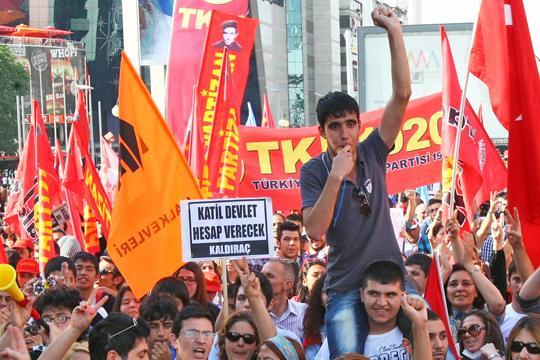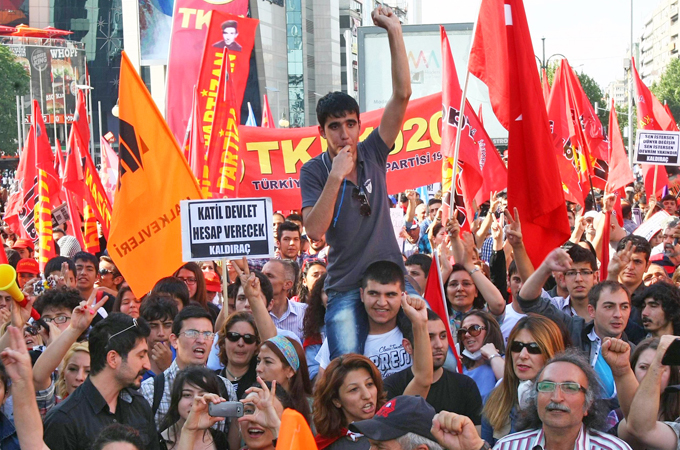
 |
| Protesters take part in a demonstration in the center of Ankara on June 8, 2013. Thousands of angry Turks poured into the streets on June 8 to join mass anti-government protests as the crisis entered it's ninth day, defying Prime Minister Recep Tayyip Erdogan's call to end the worst civil unrest of his decade-long rule [AFP PHOTO/ADEM ALTAN] |
Protests in Istanbul and other parts of Turkey have caught the government off guard. Supposedly starting as an environment-friendly gesture in Istanbul’s Gezi park that is to be replaced with a new construction unit (a city museum, shopping mall or a hotel), the sit-in turned into a large scale protest against the ruling Justice and Development (AK) Party. Many insiders, in fact, argue that protests in the last couple of days have nothing to do with the Gezi Park project. Rather, they were rather a psychological explosion of certain segments of the Turkish society against Prime Minister Recep Tayyip Erdogan himself and his 11 years of so-called “authoritarian rule.” Some commentators and observers explain the situation as a byproduct of the “cultural war” between the AK Party government and strong secular opposition forces. Others blamed Erdogan's economic policies or accused foreign agents. All of these arguments help us better understand the motives behind the protests. This piece is another such attempt that gives more emphasis to the aspects related to social media and recent social uprisings all over the world.
Firstly, there is unfortunately a lack of objective analyses about the nature of the protests. Turkey currently has a government that enjoys full economic success unlike all of its predecessors; its society has more rights today than it did a decade ago thanks to EU reforms; its middle class has grown significantly during the last 11 years; and the image of the country has totally changed from a less-influential “object” of international relations to a major “subject” in regional as well as world affairs. Hence, one wonders why Erdogan’s government has been the target of protests by his own people.
Logically, the protests cannot be seen as a result of economic issues or issues of rights and freedoms. They are, in my opinion, an expression of secular discomfort felt by some segments of the society. This dissatisfaction derives from various dynamics including Erdogan’s self-confidence in his decision-making, his neoliberal policies that work to advance a capitalist economic order as well as policies that reduce the benefits of Kemalist-era millionaires from the recent economic boom. The increasing numbers of wealthy Islamists are also a concern to the rich of the pre-Erdogan period in Turkey. The protesting groups each have arguments that fit one of these dynamics. Therefore, arguing for all-inclusive unrest based on Erdogan himself is a baseless and inadequate explanation.
Tahrir or Taksim?
Another interesting aspect of the protests is the “labeling” issue. Many have made analogies between the Istanbul protests and the Egyptian revolution that toppled former Egyptian president Hosni Mubarak. They have argued that Taksim Square now resembles the Tahrir Square of Cairo. This is an illogical and ignorant perception of the events in Turkey. The motives behind the protests in Tahrir Square differ greatly from those behind the protests in Taksim Square. Turkey is not a dictatorship in which a prime minister or president take any action or make any decisions he desire as was the case in Mubarak's Egypt. In the Egyptian revolution, the masses had no choice but to topple their corrupt 30 year-old regime. In Turkey, there is a functioning a long-standing democracy with the rule of law based on all of its principles. Throughout history, it has held free and fair elections; allowed all kinds of groups to compete in political life; promoted social movements; and provided all kinds of social, political and human rights for its citizens. Therefore, the protests in Istanbul can better be labeled as “social unrest” in which certain subgroups of the society are using their democratic rights to protest various government policies.
Nonetheless, the intervention of police forces in the protests is also democratic. The police basically aimed to stop an event that was preventing “a lawful act of policy-makers” – the demolition of some parts of the park – from being implemented. One might criticise the methods that were used by the police to disperse the protests. However, this issue should also be dealt with through the regulations of the country, which are defined by law. If a mistake has been carried out by the police, this should be investigated and those responsible should, if necessary, be charged.
Another aspect of disanalogy between the Egyptian revolution and the Istanbul protests are the actors behind the events. While in Egypt the protesters were regular citizens who had suffered the regime's harsh policies for 30 years, the Istanbul demonstrators belong to various political groups whose opinions conflict with the course of the AK Party. Tahrir Square witnessed the participation of people from all sectors of society and of all political backgrounds. However, in Istanbul, the crowds represent a certain ideological fragment of the political landscape in Turkey. A simple calculation would be enough to realise this fact. The AK Party and the Nationalist Movement Party have officially declared that they will not participate in the protests. The Kurdish nationalist Peace and Democracy Party announced their reservations regarding the protests. There are also other religious and liberal parties whose participation in the protests is not very likely. The total amount of those parties’ votes in the last election was about 70-75%. Therefore, the political support behind the protests in Istanbul is about 25%.
Most protesters are from the Turkish middle class. This class has been the greatest beneficiary of the economic boom in Turkey that occurred in the last 11 years. However, they are not yet convinced that Erdogan’s rule is giving them enough freedom and are not satisfied with the freedoms that they have gained in the last decade. Alongside this category of protestors is a large number of socialist and leftist groups who are unhappy with the neoliberal policies of the AK Party and believe that they serve only the capitalist money centres in Turkey and abroad.
Despite the differences between Taksim and Tahrir, there are various similarities in the actual “processing” of the events. The use of social media, for example, is the most visible similarity between the two events – though the use of Twitter is much more visible in the Taksim protests than the Tahrir protests. Also, the response from international media is also very similar. Most international newschannels covered the events of Tahrir and Taksim Squares as social unrest. Furthermore, we should note that the experts employed by these channels to interpret the events in Taksim for viewers were just as incompetent as those employed to interpret the Egyptian revolution. Also, both squares witnessed instigators who tried to influence the actual raison d'être of the protests. Various groups tried to impose their own agenda, causing clashes between protesters and riot police. It is important to mention the similarities between these events because they can give us an idea about social unrests in the post-modern age, which is needed to create a novel explanation for understanding the new type of social uprisings within the broader literature of revolutions.
If one asks for other cases that are similar to the current protests in Turkey, Argentina in 2001 and the United Kingdom in 2011 can offer some food for thought. The social, political and economic backgrounds of the protesters in Turkey and in Argentina are very similar. They are mostly from middle class families and belong primarily to leftist political ideologies. However, the communication methods of the protesters in Turkey are very comparable to those of the protesters in the United Kingdom, with Twitter and text messages as the primary tools for organising and controlling the events. Other social protests in the more recent past have had similar methods, activities, processes and developments, such as Greece and the United States (2011), Spain (2012) and Sweden (2013). Nonetheless, in a way, the Istanbul protests represent a perfect model for a spontaneous social media-driven and multi-actor social uprising that can take place in a democratic setting.
The Right to “Protest” against the Government?
Whatever their motives are, non-violent protests must be allowed in any democratic regime. However, if protesters abuse this right and behave undemocratically, security forces are to stop them. Yet, the police should be very careful about remaining proportionate so that the nature of the involvement does not exceed the boundaries of “legal intervention.”
Erdogan still has the support of an important division of the Turkish society. This legitimises his decisions regarding various issues. The argument of his “exclusionary attitude towards other segments of the society” is understandable but is not necessarily an issue of concern for the ruling party. This also does not give any observers the right to label Erdogan as an “autocratic leader.” Still, it is always better for a person in power to strive for a much larger consensus over a decision that might affect the lives of millions. Otherwise, likelihood of these kinds of democratic protests becomes greater in the upcoming months.
Ismail Numan Telci is a PhD Candidate in the Department of International Relations, Sakarya University, Turkey and a Visiting Scholar at the Center for Civilization Studies and Dialogue of Cultures, Cairo University, Egypt.
Copyright © 2013, Al Jazeera Center for Studies, All rights reserved.
